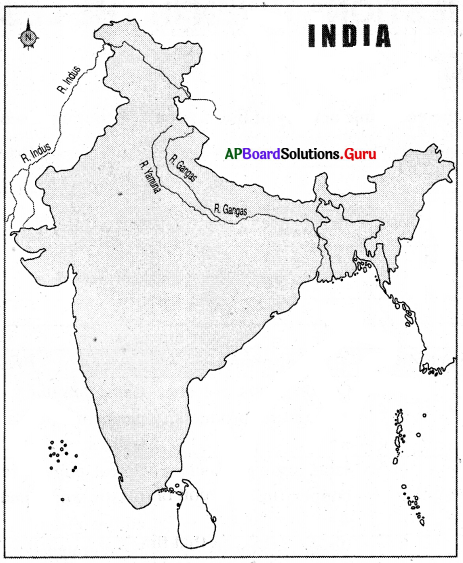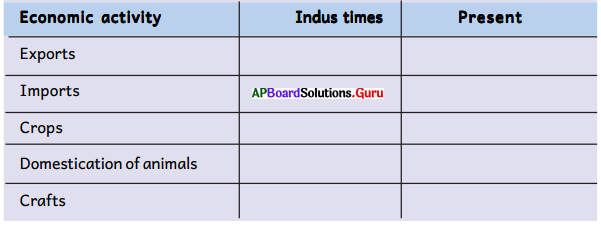SCERT AP Board 6th Class Social Solutions 6th Lesson Early Civilisations Textbook Questions and Answers.
AP State Syllabus 6th Class Social Studies Solutions 6th Lesson Early Civilisations
6th Class Social Studies 6th Lesson Early Civilisations Textbook Questions and Answers
Improve Your Learning
Question 1.
Write the similarities between Indus and Vedic civilisation.
Answer:
Religious features: Both Harappan people and Vedic people worshipped nature and Hindu gods such as Shiva and Sakti.
Baked bricks, pottery, and wheeled carts were used both by Harappan and Vedic people.
Question 2.
Who participated in the excavations of the Indus valley civilisation?
Answer:
In 1850, the British engineers while laying a railway line between Karachi and Lahore excavated the Indus valley civilization. In 1920 the archeologists realised that it was a very did civilisation.
![]()
Question 3.
Describe the economic life of the Indus people.
Answer:
- The economy of the Indus valley civilization was based upon agriculture and trade.
- Weaving cotton and woolen clothes were their main occupation. Indus people were the earliest to produce cotton.
- Production of baked bricks was another occupation of Indus people.
- Crops such as wheat, barley, peas were raised by the Indus people.
- They carried trade with other countries like Egypt, Mesopotamia, Afghanistan, and Iran also.
- They carried their international trade through Lothal port in the Arabian Sea.
Question 4.
How did the Indus people build their houses?
Answer:
The buildings of Indus people were well planned. It is clear that they possessed a flourishing urban culture. There were wide roads, public wells. Houses were made of bricks which were found in so many other areas across this civilization also. There were two-storied buildings also. Every house was connected directly to an excellent main drainage system. A great tank was built for a public bath which now was called as “the Great Bath”. Large granaries and quarters for labor were specially built in the Indus civilization.
Question 5.
The drainage system of Indus was exemplary. How?
Answer:
- The Indus civilization had an elaborate sanitary and drainage system. They maintained a highly efficient drainage system.
- Importance was given to cleanliness and public health.
- They maintained an underground drainage system for the streets. They were connected to the main drainage system.
Question 6.
“Devotion of God is belief”. Comment on Indus people’s deities.
Answer:
- Indus people believed in God. They believed in image worshipping.
- They worshipped Pasupathi (Shiva) and the mother of the Goddess.
- They accepted the pipal trees as sacred.
- They worshipped neem trees, sun, fire, earth, water, and snakes also.
- Fire pits and yagna vatikas are also found.
- Swastik symbols were found in the archeological remains of the Indus valley civilization.
![]()
Question 7.
How many Vedas are there? What are they?
Answer:
There are four Vedas in the Vedic culture. They are:
- Rig Veda,
- Yajur Veda,
- Sama Veda and
- Atharvana Veda.
Question 8.
“Veda means superior knowledge”. Comment on it.
Answer:
- The term ‘Veda’ means “Superior Knowledge” in Sanskrit.
- They are the most ancient religious texts which define truth for Hindus.
- They are the most important sources of knowledge about the Aryans and the Vedic Period.
They are called shrutis which means hearing. - Vedas are the universal truths that were discovered or realized by learned people.
- They formed the bedrock for Indian philosophy and Yoga.
- Vedas contain deeper spiritual and scientific knowledge.
- The Vedic traditions are continued till today and are still unbroken.
- Research on Vedas is carried out in many Indian and foreign Universities also. Swami Dayananda Saraswati gave a call “Go back to the Vedas”.
Thus we can say the Vedas mean superior knowledge.
Question 9.
Write about the social life of the early Vedic period.
Answer:
The Vedic literature is the major source to understand the Vedic period. The period of Rig Veda is called the early Vedic period.
The social life of the early Vedic period:
- The family was regarded as the basic unit of society.
- The father was the head of the family.
- The joint family system was in practice at that time.
- The prisoners of war were called dasas and they were like slaves.
- Monogamy was the usual practice of the Vedic period.
![]()
Question 10.
What do you know about the political life of the early Vedic period?
Answer:
- The polity of the Early Vedic period was basically a tribal polity with the tribal chief in the center. The tribe was called ‘Jana’, and the chief of that Jana was called ‘Rajan’.
- Rajan looked after the affairs of the tribe with the help of other tribal members. There are two tribal assemblies 1) Sabha and 2) Samiti.
- Rajan was not a dictator, Kingship was not hereditary.
Question 11.
What is the importance of epics?
Answer:
- The epics tell us the right way to life.
- They tell us what the importance of speaking the truth is.
- They tell us that why we should have the basic manners in our lives in an interesting manner.
- They tell us the importance of becoming a good human being.
- We should read these epics because they fill our minds with knowledge and wisdom.
- Epics tell us that how should we behave in society.
In Ramayana Rama is an ideal ruler, ideal brother, ideal son. Sita is ideal for Indian womanhood.
Mahabharata is a victory of Dharma over Adharma.
Question 12.
Locate the following rivers on the outline map of India
a) River Indus b) River Ganges c) River Yamuna
Answer:

![]()
Question 13.
What were the reasons for the decline of the Indus valley civilization?
Answer:
- Some are of the opinion that the invasion of the Aryans was the cause for the decline of Indus valley civilization.
- Change of course of the river Indus changed the area into the sand and affected the fertility and this led to the decline of the Indus valley civilization.
- Due to changes in climatic conditions, the area lost fertility and people were compelled to move to another area.
- Constant use of firewood for brick manufacture caused deforestation and low rainfall.
Project Work
Make a project on the similarities of Indus civilization and Vedic civilization.
Answer:
The Indus Valley civilization and the Vedic civilization had the following similarities.
- Both worshipped Hindu Gods such as Sakthi and Siva.
- Both believed in some sort of life after death.
They also played pre-Indian games such as gambling, dicing, and horse cart riding. The remains of a stone sculpture of a priest say that their society of most similar to that of Vedic culture.
6th Class Social Studies 6th Lesson Early Civilisations InText Questions and Answers
Let’s Do
Question 1.
Compare the economic activity of Indus people with the present. (Textbook Page No. 66)

Answer:
| Economic activity | Indus times | Present |
| Exports | Cotton goods, pottery agricultural products. | Gems, jewellary, ready-made garments metals, cotton, yarn, and fabrics. |
| Imports | Jade, agate gold, silver, copper, tin. | Petrol, paper, precious stones, plastic wool, medicines, machinery, edible oil. |
| Crops | Wheat, barley, dates cotton, mustard. | Foodgrains, cotton, jute, sugarcane tobacco, oilseeds, coffee, tea, coconut fruits, vegetables. |
| Domestication of animals | Sheep, goat, buffalo, dog, cat, pig, elephant. | Cow, buffalo, oxen, sheep, goat, horse, camel, elephant, pig etc. |
| Crafts | Jewellery, Art, necklaces, bangles, combs, idol-making. | Shawls, woodwork, pottery, leather, jute, shell, brass handicrafts, bamboo handicrafts. |
Question 2.
Compare the metals used in the Indus civilization with the present day. (Textbook Page No. 67)

Answer:
| Metals used in the Indus civilization | Metals used now |
| Gold, copper, silver, bronze metals were the metals known to Indus Valley Civilization people. | At present we are using gold, copper, silver, bronze, platinum, brass and Iron metals. |
![]()
Question 3.
List out the names of famous books and its writers from your school library. (Textbook Page No. 72)
Answer:
- The Story of My Experiments with Truth – Mahatma Gandhi
- The Discovery of India. – Jawaharlal Nehru
- ………………………………………………………………….
- ………………………………………………………………….(Student Activity)
Think and Respond
(Textbook Page No. 65)
Question 1.
Do you find any difference between the planning of Indus cities and the present cities? How?
Answer:
- The Indus valley cities were established on a good plan. The modern Indian cities are not based on any such plans.
- Both the Indus valley and the modern Indian cities have a drainage system but the modern drainage system does not work properly when compared to the Indus valley cities.
- There were citadels in the Indus valley civilization while there is no citadels in the modern Indian cities, (maybe because of population increase)
Question 2.
Was the Indus drainage system more advanced? Why?
Answer:
The Indus drainage system is well planned underground drainage system. The drainage system which was followed by the Indus people was a great achievement. Every house is connected with pipes which carry waste into the main drains.
![]()
(Textbook Page No. 69)
Question 3.
Do you find any similarities among these ancient (Mesopotamia, Egypt, Indus valley, and China) civilizations?
Answer:
Yes, we can find similarities among these ancient civilizations.
- All the civilisations grew along mighty rivers.
- All the civilisations have similarities in their settlements.
- All the civilisation developed religions to explain the forces of nature and their roles in the world.
- All the civilizations made efforts in the fields of science and technology.
Question 4.
In what ways is the Indus valley civilisation more advanced among them?
Answer:
In the Indus valley civilisation a strong and centralized government was established. The people in the Indus valley civilisation built their houses with dried or baked bricks. They built two-storeyed buildings also. Every house had a well for water and bathrooms with pipes that carried waste into the main drains. The cities of the Indus valley civilisation were well planned. They were protected by forts. They had wide roads, public wells. They had a well-planned underground drainage system which shows the importance given to cleanliness and public health. We don’t find this type of development in other civilizations of that time.
Question 5.
Write the names of religions in our country. (Textbook Page No. 71)
Answer:
Hinduism, Buddhism, Jainism, Sikhism, Islam, Christianity, Zoroastrianism, Judaism, Animism, Dony polo, and Nirankari.
![]()
Question 6.
How are our public representatives elected? (Textbook Page No. 72)
Answer:
Our public representatives are elected in both direct and indirect elections.
